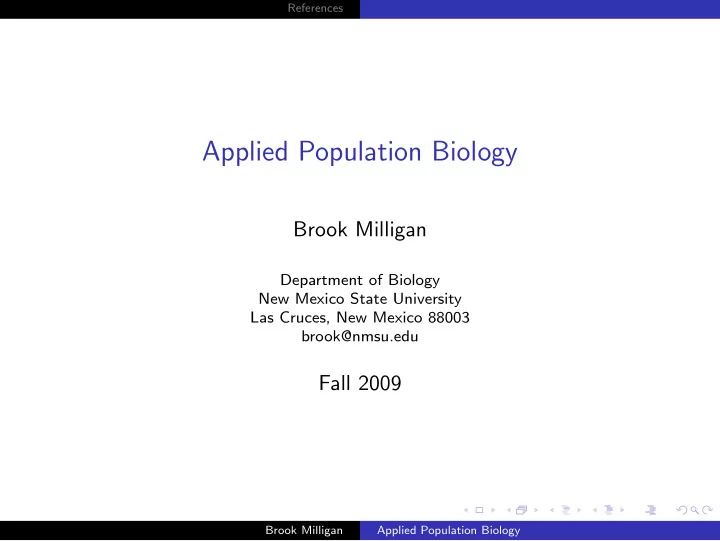

References Applied Population Biology Brook Milligan Department of Biology New Mexico State University Las Cruces, New Mexico 88003 brook@nmsu.edu Fall 2009 Brook Milligan Applied Population Biology
References Questions of Importance to Thorough Conservation Plans How should one determine if a specific conservation plan is likely to succeed? Given that natural populations generally fluctuate, how can additional disturbance caused by human activities by measured? Brook Milligan Applied Population Biology
References Answers Require Information of Many Sorts Environment What habitat requirements exist? How variable is the environment? What human activities influence the environment? Brook Milligan Applied Population Biology
References Answers Require Information of Many Sorts Environment Distribution How are individuals distributed within their habitat? Is new habitat colonized? Does movement or migration occur among habitat patches? Brook Milligan Applied Population Biology
References Answers Require Information of Many Sorts Environment Distribution Biotic interactions What interspecific interactions exist? How have human activities influenced interspecific interactions? Brook Milligan Applied Population Biology
References Answers Require Information of Many Sorts Environment Distribution Biotic interactions Morphology What is the shape, size, color of body parts? What is the function of body parts? Is there geographic variation in morphology? Brook Milligan Applied Population Biology
References Answers Require Information of Many Sorts Environment Distribution Biotic interactions Morphology Physiology What energy, water, and mineral requirements exist? How is environmental stress managed? Brook Milligan Applied Population Biology
References Answers Require Information of Many Sorts Environment Distribution Biotic interactions Morphology Physiology Demography What is the current population size, how has it changed in the past? How might population size change in the future? Brook Milligan Applied Population Biology
References Answers Require Information of Many Sorts Environment Distribution Biotic interactions Morphology Physiology Demography Behavior What behaviors of an individual allows it to survive and reproduce? How do individuals interact with each other? Brook Milligan Applied Population Biology
References Answers Require Information of Many Sorts Environment Distribution Biotic interactions Morphology Physiology Demography Behavior Genetics How much variation exists in morphological, physiological, and behavioral traits? How much of that variation is influenced by genetic differences among individuals? What fraction of the genome is variable and how variable is the variable component? Brook Milligan Applied Population Biology
References Answers Require Information of Many Sorts Environment Distribution Biotic interactions Morphology Physiology Demography Behavior Genetics Human interaction How do human activities influence the species? What is known by local people? Brook Milligan Applied Population Biology
References Answers Require Information of Many Sorts Environment Distribution Biotic interactions Morphology Physiology Demography Behavior Genetics Human interaction Brook Milligan Applied Population Biology
References Sources of Information Published scientific literature Agency and NGO reports Fieldwork and monitoring inventories count of individuals present typically covers all individuals surveys repeatable sampling design to estimate population size typically covers subset of individuals demography histories of known (e.g., marked) individuals estimates of growth, survival, and reproduction projections of population structure possible Brook Milligan Applied Population Biology
References Using Information to Improve Managaement: Population Viability Analysis (PVA) Need: quantify outcome under “what if . . . ” conditions Mathematical population model, including management-based parameters Exploration of parameter space: alternative management options Quantitative assessment of alternative management scenarios in terms of mean time to an event extinction reach a management goal probability of an event within N years extinction population size above or below a threshold Brook Milligan Applied Population Biology
References PVA Example: Caretta caretta Declining loggerhead turtle ( Caretta caretta ) populations Major mortality of eggs and hatchlings Extensive effort managing nesting beaches Is this the right management strategy? Are there other management actions that would be better? Brook Milligan Applied Population Biology
References PVA Example: Pedicularis furbishiae Brook Milligan Applied Population Biology
References PVA Example: Pedicularis furbishiae Brook Milligan Applied Population Biology
References PVA Example: Pedicularis furbishiae Brook Milligan Applied Population Biology
References PVA Example: Pedicularis furbishiae Brook Milligan Applied Population Biology
References PVA Example: Pedicularis furbishiae Brook Milligan Applied Population Biology
References PVA Example: Pedicularis furbishiae Brook Milligan Applied Population Biology
References Metapopulations Defining characteristic shifting mosaic of populations (= subpopulations) linked to some degree by migration locally extinct subpopulations are recolonized Types of metapopulations equivalent, short-lived populations: e.g., Pedicularis furbishiae source, sink populations with extinction one of more large, persistent population(s) remaining small, transient populations recolonization of extinct transient populations by colonists from perstent population source, sink populations with rescue: e.g., California peregrine falcons one of more large, persistent population(s) remaining small, not transient, but not self-sufficient populations small populations rescued by colonists from large population Brook Milligan Applied Population Biology
References Menges, E. S. 1990. Population viability analysis for an endangered plant. Conservation Biology , 4:52–62. Brook Milligan Applied Population Biology
Recommend
More recommend